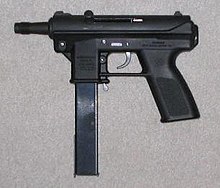Intratec Tec-9
| TEC-9 / TEC-DC9 / AB-10 | |
|---|---|

Intratec TEC-9 (AB-10 Shown)
|
|
| Type | Semi-automatic pistol |
| Place of origin | |
| Production history | |
| Designer | George Kellgren |
| Manufacturer | Intratec |
| Produced | 1985—2001 |
| No. built | 257,434 |
| Variants |
|
| Specifications | |
| Weight | 1.23–1.4 kg depending on model |
| Length | 241–317 mm depending on model |
| Barrel length | 76–127 mm depending on model |
|
|
|
| Cartridge | 9×19mm Parabellum |
| Caliber | 9mm |
| Action | Blowback-operated, semi-automatic pistol |
| Muzzle velocity | 1,181 ft/s (360 m/s) |
| Effective firing range | 50 m (160 ft) |
| Feed system | 10-, 20-, 32-, 36- and 50-round box magazine, 72-round drum magazine |
| Sights | Iron sight |
The Intratec TEC-9, TEC-DC9, or AB-10 is a blowback-operated semi-automatic pistol. It was designed by Intratec, an American offshoot of Interdynamic AB. The TEC-9 was made of inexpensive molded polymers and a mixture of stamped and milled steel parts. The simple design of the gun made it easy to repair and modify.
Swedish company Interdynamic AB of Stockholm designed the Interdynamic MP-9 9mm submachine gun. Interdynamic intended it as an inexpensive submachine gun based on the Carl Gustav M/45 for military applications, but did not find a government buyer, so it was taken to the US market as an open-bolt semi-automatic pistol. The open-bolt design was deemed too easy to convert to full auto. Because of this, the ATF forced Interdynamic to redesign it into a closed-bolt system, which was harder to convert to full auto. This variant was called the KG-99. It made frequent appearances on Miami Vice, where it was legally converted to full auto by Title II manufacturers. The KG-9 and KG-99 have an open-end upper receiver tube where the bolt, recoil springs, and buffer plate are held in place by the plastic/polymer lower receiver frame. This design only allows for 115 grain 9mm ammunition. If heavier grain ammunition or hot loads are used, the plastic lower receiver will fail or crack, rendering the firearm unusable. The later model TEC-9 and AB-10 have a threaded upper receiver tube at the rear and a screw-on end cap to contain the bolt, recoil spring, and buffer plate even if removed from the lower receiver. This solves the problem of lower receiver failure when using hot ammo.
The TEC-9 was produced from 1985 to 1994.
After the 1989 Cleveland School massacre, the TEC-9 was placed on California's list of banned weapons. To circumvent this, Intratec rebranded a variant of the TEC-9 as a TEC-DC9 from 1990 to 1994 (DC standing for "Designed for California"). The most noticeable external difference between the TEC-9 and the later TEC-DC9 is that rings to hold the sling were moved from the side of the gun with the cocking handle to a removable stamped metal clip in the back of the gun. The TEC-9 and TEC-DC9 are otherwise identical.
...
Wikipedia
